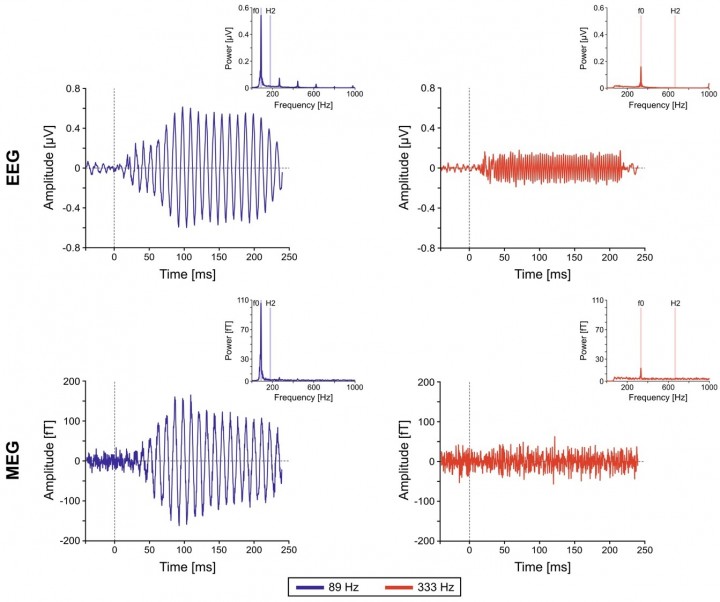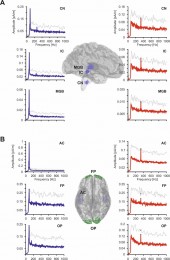The paper entitled Neural generators of the frequency-following response elicited to stimuli of low and high frequency: a magnetoencephalographic (MEG) study, by, Gorina-Careta, Kurkela, J.L.O., Hämäläinen, J., Astikainen, P., and Escera, has been published in the journal Neuroimage.
This paper is the outcome of a scientific collaboration between the Brainlab and the Active Mind Lab, led by Dr. Piia Astikainen at the University of Jyväskylä (Finland), to investigate the neural generators of the Frequency-Following Response (FFR) by means of Magnetoencephalography (MEG).

In short, participants’ electric (EEG) and magnetic (MEG) FFRs were recorded to pure tone stimuli of two different frequencies: low (89 Hz) and high (333 Hz). Results showed, confirming our hypothesis, that FFRs elicited to low frequencies were generated along the entire auditory hierarchy, with a prominent cortical source, whereas FFRs to high frequency tones, surpassing the neural phase-locking capabilities of the auditory cortex, received subcortical contributions only (from the inferior colliculus and the medial geniculate body of the thalamus). Two lessons are to learn from the present results:1) By using sufficiently high eliciting stimuli, one can use the FFR as a proxy of the subcortical auditory function in humans; 2) MEG can resolve deep neural activity down to the midbrain (IC) and even the brainstem (cochlear nucleus).

The full abstract reads as follows:
The auditory frequency-following response (FFR) to periodic complex sounds has gained recent interest in auditory cognitive neuroscience as it captures with great fidelity the tracking accuracy of the periodic sound features in the ascending auditory system. Seminal studies suggested the FFR as a correlate of subcortical sound encoding, yet recent studies aiming to locate its sources challenged this assumption, demonstrating that FFR receives some contribution from the auditory cortex. Based on frequency-specific phase-locking capabilities along the auditory hierarchy, we hypothesized that FFRs to higher frequencies would receive less cortical contribution than those to lower frequencies, hence supporting a major subcortical involvement for these high frequency sounds. Here, we used a magnetoencephalographic (MEG) approach to trace the neural sources of the FFR elicited in healthy adults (N=19) to low (89 Hz) and high (333 Hz) frequency sounds. FFRs elicited to high and low frequency sounds were clearly observable on MEG and comparable to those obtained in simultaneous EEG recordings. Distributed source modeling analyses revealed midbrain, thalamic, and cortical contributions to FFR, arranged in frequency-specific configurations. Our results showed that the main contribution to the high-frequency sound FFR originated in the inferior colliculus and the medial geniculate body of the thalamus, with no significant cortical contribution. In contrast, the low-frequency sound FFR had a major contribution located in the auditory cortices, and also received contributions originating in the midbrain and thalamic structures. These findings support the multiple generator hypothesis of the FFR and are relevant for our understanding of the neural encoding of sounds along the auditory hierarchy, suggesting a hierarchical organization of periodicity encoding.
Reference:
Gorina-Careta, N., Kurkela, J., Hämälainen, J., Astikainen, P., & Escera, C. (2021). Neural generators of the frequency-following response elicited to stimuli of low and high frequency: a magnetoencephalographic (MEG) study. Neuroimage, 117866.
Permanent doi: https://doi.org/10.1016/j.neuroimage.2021.117866.

